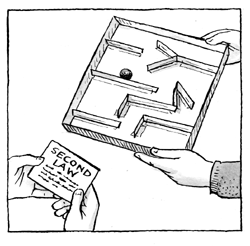|
For ages 10 and older.
Sir Isaac Newton studied other scientists' ideas and thought a lot
about how things on Earth and in the universe move. After a great
deal of work, he developed three important laws that explain how and
why things move as they do. His three laws of motion are:
-
An object at rest will stay at rest, and a moving object will
keep moving in a straight line with constant speed until a force
acts on the object.
-
An object accelerates (speeds up) because a force acts upon it.
-
For every action there is an equal and opposite reaction.
In this activity, you will make a maze and use a marble to
investigate these laws.
You will need
- cardboard box (flat lid of a shoebox is best)
-
4 of each of the following sized rectangles (made from oak tag,
index cards, or manila folders) 1 by 2 inch, 1 by 3 inch, and 1 by
5 inch
- masking tape
- 2 small marbles
- pencil
- 3 index cards
What to do
-
Work with a partner. Label each of your index cards with a
different law of motion.
-
Work together to make a maze by taping the rectangles to the
inside base of the box (all walls should be 1 inch high). Make
the tape the same length as the long side of the rectangle.
Place the tape on a long side of the rectangle so half the tape
sticks to the rectangle and half does not. Tape the rectangle to
the inside base of the box so that it stands up. Secure the
rectangle by taping its opposite side to the base.
-
Continue taping rectangles to the base to complete the maze.
Leave spaces so a marble can travel from one end to the other.
-
Conduct the following three steps with the marble:
-
Place the marble in the maze so that it is still. How can
you make the marble move? How can you make the marble move
faster? What is the force responsible for making the marble
move?
-
Place the marble at rest. Why does the marble stay still?
Tilt the box and observe. What causes the marble to move?
What causes the marble to stop or slow down?
-
Place one marble in the maze. Roll another marble into it.
What happens to the two marbles? Where does the energy of
the first marble get transferred?
-
After you have done these three tasks, look at your index cards
that contain Newton's laws of motion. Match each law to a
different step you performed. Explain your choices.

Learning More
Isaac Newton: The Greatest Scientist of All Time
by Margaret J. Anderson. Enslow, 1996.
Presents the life and work of Isaac Newton as well as hands-on
experiments related to Newton's theories of motion and gravitation.
Janice VanCleave's Physics for Every Kid: 101 Easy Experiments in
Motion, Heat, Light, Machines, and Sound
by Janice Pratt VanCleave. Wiley, 1991.
Provides a number of easy-to-do experiments and activities that
illustrate physics principles.
ZOOM's 3 Puck Chuck
www.pbs.org/zoom/games/3puckchuck
Features a game in which players must account for Newton's laws of
motion as they adjust the speed, direction, and physical properties
of a virtual puck.

|

|
Newton's Laws of Motion
Sir Isaac Newton was born in 1642. He studied at the
University of Cambridge in England. Many scientists of
his time wanted to know more about motion on Earth and
the motions of the planets. Newton was the first to
understand both of these. His three laws of motion have
helped scientists understand orbits and develop rockets
and spacecrafts.
|
|
|



